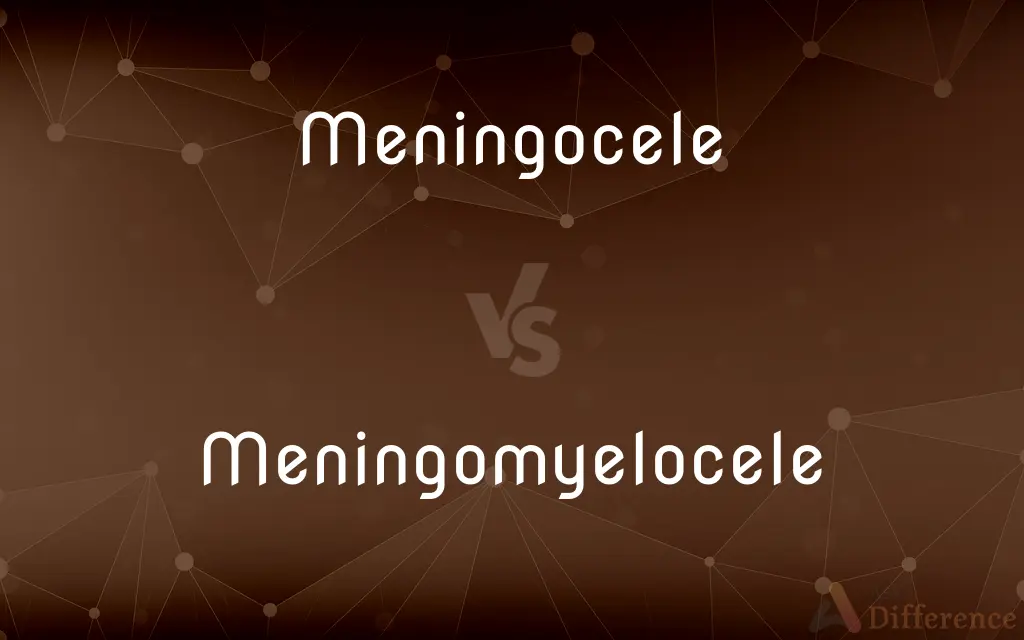Meningocele vs. Meningomyelocele — What's the Difference?
By Tayyaba Rehman — Updated on October 25, 2023
Meningocele is a protrusion of the meninges through a gap in the spine, while Meningomyelocele also involves protrusion of spinal cord tissue. Both are types of spina bifida.

Difference Between Meningocele and Meningomyelocele
Table of Contents
ADVERTISEMENT
Key Differences
Meningocele refers to a specific type of spina bifida where the meninges, the protective coverings of the brain and spinal cord, protrude through an opening in the vertebral column. This condition results in a sac-like formation, but the spinal cord itself remains undamaged and properly placed. Meningomyelocele, on the other hand, is a more severe form of spina bifida, involving not just the meninges but also portions of the spinal cord or nerve roots, leading to a more complex clinical picture.
While both Meningocele and Meningomyelocele present as protrusions, the critical difference lies in what exactly is protruding. In Meningocele, only the meninges herniate out of the vertebral defect. This might lead to fewer neurological complications compared to Meningomyelocele because the spinal cord remains unaffected. Meningomyelocele, being more intricate, often comes with a range of neurological complications due to the spinal cord's involvement.
The treatment and prognosis for Meningocele and Meningomyelocele differ. Since Meningocele is less severe and doesn't involve the spinal cord, the surgical repair might yield better outcomes with fewer neurological complications. Meningomyelocele requires more comprehensive surgical intervention and, given the spinal cord involvement, may result in persistent neurological deficits even post-surgery.
Despite their differences, both Meningocele and Meningomyelocele underline the importance of prenatal care and folic acid supplementation during pregnancy. Early detection through prenatal screenings allows for timely interventions and better planning for postnatal care.
Comparison Chart
Definition
Protrusion of just the meninges.
Protrusion of the meninges and parts of the spinal cord/roots.
ADVERTISEMENT
Involves
Only the protective coverings (meninges).
Meninges and spinal cord tissue or nerve roots.
Severity
Generally less severe.
More severe due to spinal cord involvement.
Neurological Impact
Typically minimal as the spinal cord is unaffected.
Often has significant neurological complications.
Common Treatment
Surgical repair of the defect.
More complex surgical intervention required.
Compare with Definitions
Meningocele
A type of spina bifida where only the meninges protrude through the vertebral column.
The MRI revealed a meningocele at the lower lumbar region.
Meningomyelocele
Herniation of the spinal cord and meninges through a vertebral defect.
Meningomyelocele presents greater challenges due to spinal cord involvement.
Meningocele
Herniation of the meninges through a defect in the spine without spinal cord involvement.
The newborn was diagnosed with meningocele, but thankfully, the spinal cord was intact.
Meningomyelocele
The most common and severe form of open spina bifida.
Early detection of meningomyelocele allows for better postnatal care planning.
Meningocele
A sac-like protrusion containing cerebrospinal fluid and meninges.
The surgeon explained that the meningocele would require surgical repair.
Meningomyelocele
A severe type of spina bifida involving both meninges and spinal cord/nerve root protrusion.
The ultrasound showed a meningocele and suspicion of meningomyelocele.
Meningocele
A less severe form of spina bifida without nerve tissue involvement.
Compared to meningocele, other forms of spina bifida might have worse neurological outcomes.
Meningomyelocele
A neural tube defect leading to significant neurological complications.
Children with meningomyelocele often need long-term physical therapy.
Meningocele
A neural tube defect where meninges bulge out through an opening in the vertebral column.
Prenatal screenings can detect conditions like meningocele early on.
Meningomyelocele
A sac-like protrusion containing cerebrospinal fluid, meninges, and neural elements.
The baby with meningomyelocele might require multiple surgeries.
Meningocele
A protrusion of the meninges through a gap in the spine due to a congenital defect.
Meningomyelocele
Protrusion of the meninges and spinal cord through a defect of the vertebral column; an instance of this.
Meningocele
A moderately severe form of spina bifida in which the meninges protrude, causing a bulge under the skin.
Meningomyelocele
(medicine) A congenital defect of the central nervous system of infants in which membranes and the spinal cord protrude through an opening or defect in the vertebral column.
Meningocele
(pathology) A form of spina bifida in which a meningeal sac of cerebrospinal fluid protrudes through the skull.
Meningocele
A congenital anomaly of the central nervous system in which a sac protruding from the brain or the spinal meninges contains cerebrospinal fluid (but no nerve tissue)
Common Curiosities
How does Meningomyelocele differ?
Meningomyelocele involves both the meninges and parts of the spinal cord or nerve roots protruding.
What is Meningocele?
Meningocele is a type of spina bifida where only the meninges protrude through a spinal defect.
Are there neurological issues with Meningocele?
Meningocele typically has fewer neurological complications since the spinal cord remains unaffected.
Which is more severe, Meningocele or Meningomyelocele?
Meningomyelocele is generally more severe due to the involvement of the spinal cord.
Can children with Meningocele lead normal lives?
Many children with Meningocele can lead normal lives with proper medical care.
Can Meningocele be detected during pregnancy?
Yes, prenatal screenings like ultrasounds can detect Meningocele.
How common is Meningomyelocele?
Meningomyelocele is the most common and severe form of open spina bifida.
Do both conditions have the same treatment?
While both might require surgery, Meningomyelocele often demands more comprehensive intervention.
Are there preventive measures for Meningocele?
Taking folic acid before and during early pregnancy can reduce the risk.
How is Meningomyelocele managed in adults?
Management includes monitoring, surgeries, physical therapy, and addressing related complications.
Does Meningomyelocele always result in paralysis?
Not always, but there's a significant risk of neurological complications.
What causes Meningomyelocele?
Meningomyelocele, like other spina bifida forms, can result from a combination of genetic and environmental factors.
How do Meningocele and Meningomyelocele affect daily life?
The impact varies, but Meningomyelocele often has a more profound effect on mobility and daily functions.
Why is early detection important for both conditions?
Early detection allows for timely interventions and better postnatal care planning.
Is there a cure for Meningomyelocele?
While there's no "cure," surgeries and therapies can significantly improve quality of life.
Share Your Discovery

Previous Comparison
Privilege vs. Honor
Next Comparison
Inconspicuous vs. ConspicuousAuthor Spotlight
Written by
Tayyaba RehmanTayyaba Rehman is a distinguished writer, currently serving as a primary contributor to askdifference.com. As a researcher in semantics and etymology, Tayyaba's passion for the complexity of languages and their distinctions has found a perfect home on the platform. Tayyaba delves into the intricacies of language, distinguishing between commonly confused words and phrases, thereby providing clarity for readers worldwide.
















































